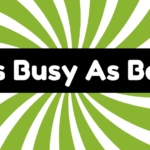The phrase "bee in a bonnet" refers to someone's obsessive fixation or preoccupation with a particular idea, often to an unsettling degree. Its origins trace back to the 1500s and may link to Scottish folklore, illustrating the agitation caused by such thoughts. It appears in various contexts, such as "She has a bee in her bonnet about recycling." This expression remains relevant, symbolizing both negative obsession and positive determination; learning more reveals its intricate usage and meanings.
Synonyms
Synonyms serve as essential tools in language, providing alternatives that enrich communication. When exploring the concept of being fixated or obsessed, it is beneficial to understand the variety of choices available. This awareness encourages nuanced expression and enhances clarity. Some obsession synonyms and fixation alternatives include:
- preoccupation
- compulsion
- fixation
- mania
Utilizing these alternatives challenges typical language use, prompting speakers and writers to convey ideas with precision. While synonyms can enhance dialogue, they require careful context to avoid losing intended meaning. Ultimately, a thoughtful selection of words leads to innovation in expression, refining how ideas are communicated.
Example of Sentences
An obsession can often reveal itself in the way individuals express their thoughts and feelings. The phrase "bee in a bonnet" captures this idea through idiomatic expressions and figurative language. Consider these sentences:
- She always has a bee in her bonnet about the recycling program.
- His sustained efforts show he really has a bee in his bonnet concerning climate change.
- The professor seems to have a bee in his bonnet over outdated teaching methods.
- They prefer not to discuss their bee in the bonnet related to social media censorship.
Such phrases illustrate how fixation can distort perceptions and guide dialogue, reflecting deeper societal concerns.
Origin
The origin of the phrase "bee in the bonnet" is quite intriguing, revealing a blend of cultural and historical nuances. Emerging in the 1500s, it possibly connects to Scottish folklore, where bees symbolize industry and focus. This phrase conjures an image of a woman's bonnet disturbed by an errant bee, suggesting agitation from an obsessive thought. Literary mentions, such as in Alexander Douglass's "Aeneis," underline its roots. While the idiom reflects a somewhat negative fixation, it also hints at the positive aspect of determination, showcasing the duality inherent in human obsessions and inspirations throughout history.
Collocations
Collocations related to the phrase "bee in the bonnet" often illustrate its nuanced meaning in everyday language. These combinations highlight bee-related obsession themes, reflecting how individuals fixate on particular ideas. Understanding these collocations provides insight into varied contexts where this phrase emerges:
- Have a bee in the bonnet
- Get a bee in your bonnet
- Buzzing with a bee in the bonnet
- A bee in her bonnet about
These expressions emphasize the idea of being consumed by thoughts, serving as a reminder of the potential for obsession to overshadow reason, urging caution and self-awareness in one's pursuits.
How to Use in Everyday Language
Understanding how to use the phrase "bee in the bonnet" in everyday language can help clarify conversations, especially when discussing someone's fixation on an idea. This casual expression is useful for highlighting individuals who are overly preoccupied with a particular concept or thought. In everyday conversations, one might say, "She has a bee in her bonnet about climate change," indicating an intense focus. Implementing this phrase can foster deeper discussions, yet it also requires careful consideration of context. Overuse may render it cliched, but when applied judiciously, it contributes nuance to dialogue, allowing for insightful exchanges about obsessions and priorities.
Why Is It Still Relevant Today?
Relevance in contemporary discussions often hinges on how language reflects human behavior, and the phrase "bee in the bonnet" maintains its significance in today's world. This idiom captures the persistence of ideas and obsessions that drive individuals, reflecting the cultural impact of focused determination. Modern interpretations showcase how heightened awareness about mental health has shifted perceptions, viewing such fixations as both strengths and weaknesses. As society progresses, recognizing this phrase can foster dialogue around passion versus obsession, urging individuals to balance their ambitions with broader perspectives. Consequently, "bee in the bonnet" remains an insightful commentary on the complexities of human thought.







